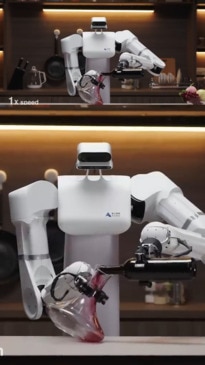Startling vision of advanced new humanoid robot that can cook and clean
As tension grows about the major potential for AI to spark mass job losses, a new humanoid robot has just been unveiled – and it can cook.

A Chinese tech company has released astounding vision of its new human-like robot, powered by artificial intelligence, with plans to release it commercially later this year.
Astribot, based in Shenzen, has been developing S1 for years and claims it’s stronger and faster than an average human at a range of tasks.
The robot can move at a top speed of 10 metres per second, the company claims, compared to an average adult male’s ability of about seven metres per second.
On top of that, each arm can carry up to 10 kilograms.

In the demonstration video, S1 is shown sorting objects, stacking cups, ironic a shirt, folding laundry, repairing a piece of furniture, watering plants, operating a vacuum and even pulling a tablecloth out from under six stacked wine glasses without them toppling.
That gives a glimpse of how such technology could be used in homes, in ways depicted in Back To The Future and The Jetsons.
But it’s the robot’s ability to peel and cut vegetables, flip toast in a pan, sprinkle precise amounts of salt, open bottle lids, pour liquid and serve up a meal that has really created a stir.
Robotic chefs are coming
The S1 announcement is the latest advancement to spark buzz in the global hospitality sector, which continues to battle staff shortages and high costs.
“They can learn, think and work like people,” Astrobot’s website says of the robots. “They can use human tools and equipment to help people complete boring, difficult or dangerous tasks.”

Hospitality tech company Loman AI predicts robots in commercial kitchens will become an increasingly common sight.
“New improvements in robotics, AI, and how robots see and understand their environment, let them do complicated cooking tasks safely,” it said in a recent article.
“The cost of these robots is going down, making it easier for more restaurants to start using them.”
Already, the food service automation and robotics industry is worth an estimated US$3.35 billion (AU$5.05 billion) globally.
Loman predicts that in time, robot chefs will become so advanced that they can come up with their own recipes, based on what people feel like eating and the ingredients available.

Last week, news.com.au reported that major US fast-food chain Wendy’s had replaced some of its drive-through staff with automated AI ordering technology.
Experts here predict it’s only a matter of time before similar tools are implemented in Australia, raising concerns about the impact of automation on job markets.
Humanoid advancements like S1 could revolutionise the food service industry in coming years.
This high level of robotic technology doesn’t yet exist in commercial kitchens, but a growing number of restaurants are turning to increasingly sophisticated methods to prepare food.
Kitchens already going robotic
In Boston in the United States, a restaurant called Spyce operates with an almost entirely robotic kitchen.
A small number of workers prepare ingredients off site, which are then delivered to robot chefs in the store, which prepare orders that customers make on digital kiosks.
When the food is ready, a human ensures the presentation is up to par and garnishes each dish, while a second real-life employee runs the dining room.
In San Francisco, burger bar Creator is home to a robotic machine that can make orders from start to finish, from slicing tomatoes and onions to cooking meat patties.
A top restaurant critic gave the food her tick of approval during a recent visit.
Another burger restaurant in California, Cali Express in Pasadena, uses a robot called Flippy in a fully automated kitchen.
The artificial intelligence-powered robots, created by Miso Technology, work both the grill and fry stations and customers interact entirely with a cashless kiosk, paying with tech called PopID.

“To our knowledge, this is the world’s first operating restaurant where both ordering and every single cooking process are fully automated,” John Miller, CEO of PopID and board member of Miso Robotics, said.
“The marriage of these various technologies to create the most autonomous restaurant in the world is the culmination of years of research, development, and investment in a family of revolutionary companies.”
The company expects this experiment to be the start of broader food service industry automation.
“AI-powered, robotic order-taking and cooking enables the major chains that feed America to substantially improve quality, consistency and speed,” Miso Robotics boss Rich Hull said.
It recently signed a partnership with American fast-food chain Jack in the Box to pilot its technology in select locations, with a possible full rollout in the future. It has also struck a similar deal with White Castle.

Another company, Chowbotics, has created a robot named Sally that can make salads, and while it was initially designed for supermarkets, the tech has started rolling out to restaurants.
Sally can make 72 custom-ordered salads in a single hour and to a precise extent, eliminate wasting and improving product consistency.
Even warehouse grocery giant Costco uses robotic automation to prepare its in-store pizzas, with one machine flattening the dough, another spreading sauce over the base, and an oven perfectly cooking it with the help of carefully set conveyor belts.
The end for chefs?
It’s too soon to declare that robots will completely replace chefs and cooks in commercial kitchens anytime soon, Loman said.
“Robots are good at doing the same thing over and over, like flipping burgers or putting together salads. However, cooking often needs creativity, a sense of taste, and the ability to adjust to many different situations.
“Robots might start doing some of the basic cooking tasks, which means chefs can spend more time on creating new dishes and making food look great. But we’ll still need the human touch, especially in fancy restaurants.”
Boom in humanoid tech
Major advancements in humanoid robot technology caused China to declare that it will be the leader in the field within a few years.
The Chinese Ministry of Industry and Information Technology has outlined goals for the country to mass-produce humanoids by 2025.
The humanoid robotics market has boomed in recent years thanks to rapid advancements in technology and a shift in understanding about how they could assist businesses.
Goldman Sachs has even tipped that they are the next smartphone, as production and manufacturing components become cheaper and potential application expands.
The financial giant expects the humanoid robotics market to be worth up to US$38 billion (AU$58 billion) annually by 2035.

The International Federation of Robotics said human-like designs with two arms and two legs allow robots to be used flexibly in work environments that were created for humans.
“Robotics is a multidisciplinary field where technologies are converging to create intelligent solutions for a wide range of tasks,” Marina Bill, president of the IFR, said.
“These advances continue to shape the merging industrial and service robotics sectors and the future of work.”
Originally published as Startling vision of advanced new humanoid robot that can cook and clean



